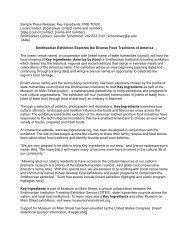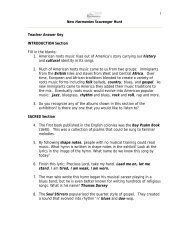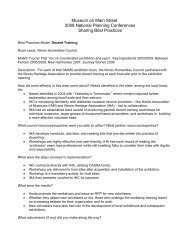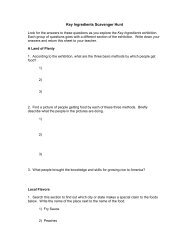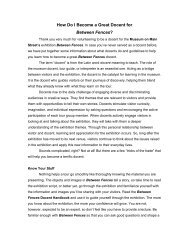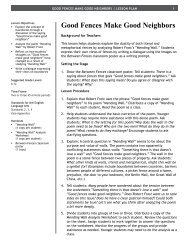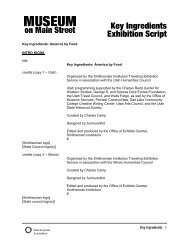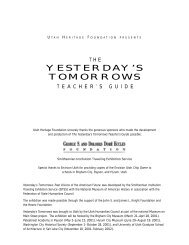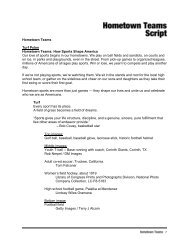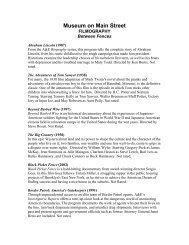Exhibition Script - Museum on Main Street
Exhibition Script - Museum on Main Street
Exhibition Script - Museum on Main Street
Create successful ePaper yourself
Turn your PDF publications into a flip-book with our unique Google optimized e-Paper software.
The Way We Worked script[Shorthand book]By using symbols instead of words, secretaries could take down dictati<strong>on</strong>faster.Gregg Shorthand Guide, ca. 1900.Secti<strong>on</strong> 3: How We WorkedNothing affected the way we work like technology. Until the early 1800s, most jobs involvedmanual labor and animal power, but new inventi<strong>on</strong>s helped ignite an industrial revoluti<strong>on</strong>. Howwe worked changed forever.Mills and factories sprang up, towns were born, and innovati<strong>on</strong>s helped farmers produce more.Cottage industries gave way to city and factory jobs. Workers banded together in uni<strong>on</strong>s toprotect their rights and lives amid the industrial rush.Technology c<strong>on</strong>tinues to change how we work. How will it change our future?BEFORE THE SMARTPHONETeleph<strong>on</strong>e calls used to be switched manually. Skilled operators c<strong>on</strong>nected callsin less than 4 sec<strong>on</strong>ds and often gave local news and train alerts, too.Switchboard operators direct overseas calls, December 1943.Nati<strong>on</strong>al Archives, Records of the Women’s Bureau“Every great inventi<strong>on</strong> takes a livelihood away from 50,000 men &within ten years creates a livelihood for half a milli<strong>on</strong>.”--Mark Twain, letter to William Dean Howells, 1888Banner:Technology, Tools, Computers, Plow, Industry, Farms, United, Machines,HandcraftedBackground Image:Riveter at Hog Island Shipyard, Pennsylvania, 1918.Nati<strong>on</strong>al Archives, Records of the War DepartmentFROM AGRICULTURE TO INDUSTRYBeginning about 1830, waves of Americans left the countryside to work in cities, wherenew technology changed lives. In factories, mills, offices, and shops, life now revolvedaround the clock instead of the seas<strong>on</strong>s. Engineers and laborers built modern w<strong>on</strong>derswith huge machines.MOVING THE EARTHMammoth projects called for mammoth machines. Behemoths like the “five-yarddipper” helped the 12,000-pers<strong>on</strong> workforce build the Grand Coulee Dam. Mas<strong>on</strong>City, Washingt<strong>on</strong>—the first completely electric city in America—was built tohouse the workers.Worker <strong>on</strong> a “five-yard dipper” during c<strong>on</strong>structi<strong>on</strong> of Grand CouleeDam, Washingt<strong>on</strong>, April 1936.Nati<strong>on</strong>al Archives—Rocky Mountain Regi<strong>on</strong> (Denver, Colorado),Records of the Bureau of Reclamati<strong>on</strong>11



